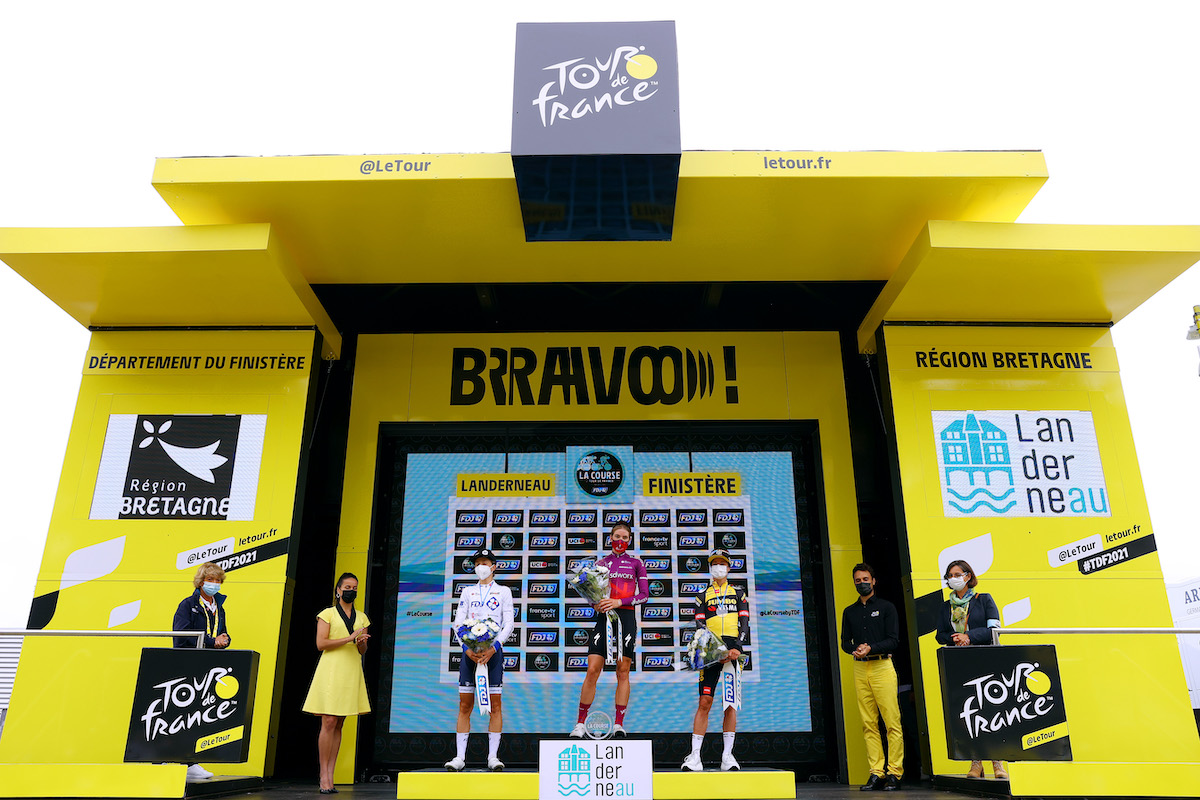The Tour de France Femmes in numbers: stunning stages but some unimpressive wages
There’s lots to be excited about…as long as you look past the prize money and riders' wages


Eight stunning stages, 144 riders, the richest prize purse of the year, and world-wide coverage.
The 2022 Tour de France Femmes avec Zwift is shaping up to be a great showcasing of women’s cycling, and one we’ve been pushing for since the last official women’s Tour de France was discontinued after 1989.
As we’re counting down the final hours until the women’s peloton rolls from the Eiffel Tower start line, here are some facts and figures — both good and cringe-worthy.
The Good
- 8 beautiful stages, containing both flat sprint and mountain top finishes, cobbles and gravel sectors, city streets and country lanes. Making up the tour are:
- 4 flat stages
- 2 hilly stages
- 2 mountain stages
- 1033.6 kilometers in total with
- 23 climbs and a total elevation gain of 13,140 meters
- 1,336 meters = the altitude of Grand Ballon, the highest point of the Tour de France Femmes
- 175.6 kilometres (109.1 miles) = the longest stage — stage 5 — and also the longest professional women's road race stage in modern history.
- 144 riders from 24 teams
- 32 riders vying for the white Best Young Rider jersey
- 300 staff, including
- 8 female Sports Directors: Anna van der Breggen (SD Worx), Ina Teutenberg (Trek-Segafredo), Jolien D’Hoore (AG Insurance NXTG), Lieselot Decroix (Jumbo-Visma), Joanna Kiesanowski (Human Powered Health), Heidi van der Vijver (Plantura-Pura), Alexandra Greenfield ( Uno-X), Charlotte Bravard (St. Michel Auber 93).
- 5 continents and 190 countries will have live broadcasting, offering
- 2.5 hours of daily coverage
- 100% of the Skoda fleet of cars is electric or hybrid
The Grey Area
- €250,000 in prize money. While this may be the richest prize purse of the year for the women’s peloton, it pales in comparison to the men’s €2.2 million prize pot.
- The men's winner alone — likely Jonas Vingegaard— will walk away with €500,000, while the women's winner on the top of La Planche des Belles Filles at the end of stage 8 will get a mere tenth of that: €50,000.
- The races traverses across just 3 regions —Ile-de-France, Grand Est, Bourgogne-Franche-Comte — making it more of a Tour of Northeast France rather than a full country tour. But on the bright side, that means no long transfer days either.
The Bad
Out of the 24 teams on the start line, 14 of them are official UCI WorldTour (WWT) teams. The others are UCI Pro Continental teams.
In women's cycling, the UCI dictates that WWT must pay their riders a minimum salary of €27,500 ( for employed) or €45,000 (for self-employed a.k.a independent contractors). Continental teams, however, have no such obligations and many riders in the pro peloton remain unpaid.
With that in mind, Cycling Weekly spoke to The Cyclists' Alliance, an international independent union for female cyclists that provides holistic support to female cyclists during and after their careers. The entity also conducts an annual, anonymous survey on salary, contracts and working conditions of professional female cyclists.
The latest survey collected salary data across more than 40 road cycling teams in 2022, many of which —if not all— will be at the starting line on Sunday.
The latest race content, interviews, features, reviews and expert buying guides, direct to your inbox!
Cycling Weekly was told that while some Continental team riders do receive a salary that matches the minimum wage requirements of a Women’s World Tour, that percentage is rather small.
Only 10 to 15 percent of Continental riders received a salary that was equivalent to the WWT minimum salary. Based on their survey results, around 60 percent of non- WWT professional cyclists do not get paid at all.
With a look at the start list for the Tour de France Femmes specifically, it's safe to extrapolate that 40 percent of the Continental teams in the TdFF appear to pay their riders less than a living minimum wage. Many of these riders pay less than €15,000, less than €5,000 or nothing at all.
Now these sobering numbers aren't meant to dampen anyone's celebration of the Tour de France Femmes avec Zwift. If anything, they're meant to inform and raise awareness about the need for more big scale and widely broadcasted women's events such as this. It's also why this race is being touted so much by teams, sponsors and media alike.
The Tour de France is the most recognizable and celebrated cycling event in the world. For the women's peloton this is their moment to shine and showcase their talent, dedication and expertise. More importantly, it's a huge opportunity for exposure, which is crucial in attracting more sponsorship funding (for better salaries!), future talent and fans.

Cycling Weekly's North American Editor, Anne-Marije Rook is old school. She holds a degree in journalism and started out as a newspaper reporter — in print! She can even be seen bringing a pen and notepad to the press conference.
Originally from the Netherlands, she grew up a bike commuter and didn't find bike racing until her early twenties when living in Seattle, Washington. Strengthened by the many miles spent darting around Seattle's hilly streets on a steel single speed, Rook's progression in the sport was a quick one. As she competed at the elite level, her journalism career followed, and soon, she became a full-time cycling journalist. She's now been a journalist for two decades, including 12 years in cycling.